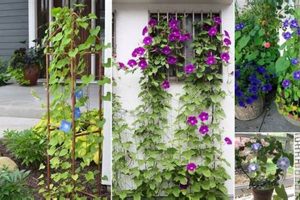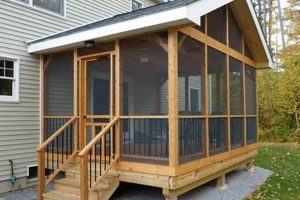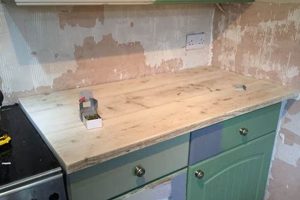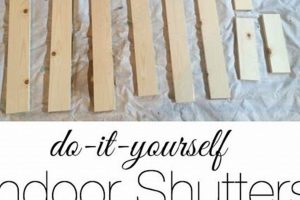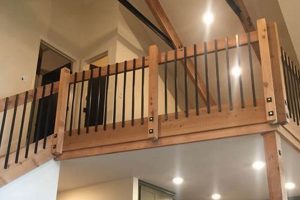The core concept revolves around creative and personalized lighting solutions achieved through handcrafted lampshades. These encompass a broad spectrum of techniques and materials employed to modify or construct lampshades independently, diverging from commercially manufactured alternatives. For example, repurposing fabric scraps, manipulating paper, or incorporating natural elements constitute instances of this practice.
The significance of crafting customized light fixtures resides in the capacity to imbue interior spaces with unique aesthetic character and personalized ambiance. This approach offers an avenue for expressing individual style, aligning decor with specific preferences, and minimizing waste by upcycling existing resources. Historically, homemade lampshades reflected resourcefulness and individual artistry, evolving alongside trends in interior design and advancements in material availability.
Subsequent sections will detail diverse methods for creating distinctive lighting features, including fabric manipulation techniques, paper-based designs, and the integration of found objects, offering a practical guide to initiating independent lighting projects.
Crafting Personalized Lampshades
Achieving successful results in handcrafted lampshades requires careful planning and execution. The following tips offer guidance for optimal outcomes.
Tip 1: Material Selection: Consider the light transmission properties of selected materials. Opaque fabrics will produce directed light, while translucent options diffuse it more evenly. Test material opacity before commencing the project.
Tip 2: Frame Acquisition and Preparation: Secure an appropriate lampshade frame. Clean and, if necessary, repaint metal frames to prevent rust or corrosion from impacting the final aesthetic. Ensure structural integrity before applying covering materials.
Tip 3: Precise Measurement and Cutting: Accurate measurements are critical. Cut fabric or paper with ample allowance for seams and adjustments. Utilize patterns when available to ensure consistent shaping and reduce material waste.
Tip 4: Adhesive Application: Employ adhesives specifically designed for fabric or paper, depending on the chosen material. Apply adhesive evenly and sparingly to prevent seepage or discoloration. Allow adequate drying time as per the adhesive manufacturer’s instructions.
Tip 5: Tension Control: When applying fabric, maintain even tension to avoid wrinkles or sagging. Use clips or pins to secure fabric in place while the adhesive dries. Consistent tension contributes to a professional finish.
Tip 6: Seam Management: Strategically position seams to minimize visibility. Opt for discreet seam finishes, such as rolled hems or hidden stitching, to enhance the overall appearance of the finished product.
Tip 7: Edge Finishing: Neatly finish the top and bottom edges of the lampshade. Binding with fabric tape or decorative trim provides a polished look and prevents fraying.
Adherence to these suggestions will significantly enhance the quality and durability of handcrafted light fixtures, offering both functional illumination and unique decorative appeal.
The subsequent section will explore design inspirations and advanced techniques for lampshade customization.
1. Material Selection
Material selection represents a foundational determinant within the realm of handcrafted lighting. The characteristics of chosen materials dictate not only the aesthetic properties but also the functional performance of the resulting light fixture.
- Light Transmission Properties
The transparency or opacity of the selected material directly influences the diffusion and intensity of light emitted. Opaque materials, such as tightly woven fabrics or treated paper, produce focused light with minimal dispersion. Conversely, translucent materials, including parchment paper or loosely woven textiles, yield a softer, more diffused glow. The selection hinges on the desired ambiance within the designated space.
- Texture and Visual Appearance
Materials introduce tactile and visual texture, contributing significantly to the lampshade’s aesthetic appeal. Rough textures, such as burlap or linen, impart a rustic or natural feel, while smooth surfaces, like silk or satin, evoke a more refined and elegant aesthetic. Patterned fabrics or textured papers introduce visual complexity and can complement or contrast with existing decor.
- Durability and Longevity
The inherent durability of materials affects the lampshade’s lifespan and resistance to wear and tear. Robust fabrics, such as canvas or denim, withstand prolonged use and offer increased resistance to fading or damage. Delicate materials, such as silk or lace, require more careful handling and maintenance to prevent deterioration.
- Safety Considerations
The flammability of materials poses a crucial safety concern. Materials should ideally be inherently flame-resistant or treated with flame-retardant coatings to mitigate fire hazards. Proximity to heat sources, such as incandescent light bulbs, necessitates careful selection to minimize the risk of ignition.
Ultimately, material selection in custom lighting necessitates a careful evaluation of aesthetic preferences, functional requirements, and safety considerations. The chosen materials should harmonize with the intended design, provide the desired light quality, and ensure the safe and enduring performance of the crafted light fixture.
2. Frame Structure
The structural integrity of the frame is paramount in the successful execution of handcrafted lighting projects. It establishes the shape, provides support for the covering material, and determines the overall durability of the completed lampshade. The frame serves as the foundational element upon which all subsequent design decisions are built.
- Shape and Form
The configuration of the frame dictates the final form of the lampshade, influencing the direction and distribution of light. Common shapes include cylindrical, conical, and empire, each offering distinct aesthetic characteristics and lighting effects. The selection of a frame shape aligns with the intended style of the room, the base of the lamp and the requirements for light levels. For instance, a conical frame directs light downwards more effectively, while a cylindrical frame distributes light more evenly.
- Material Composition and Strength
The material used in frame construction impacts both the weight and structural integrity of the lampshade. Metal frames, typically constructed from wire or wrought iron, offer high strength and durability, suitable for larger or more complex designs. Plastic or wooden frames provide
lighter alternatives, but may be less resistant to stress and impact. The gauge and type of material influence longevity. - Attachment Points and Stability
The frames design incorporates attachment points that facilitate secure mounting to the lamp base. These points must be appropriately positioned and robust enough to support the weight of the lampshade and withstand potential movement or vibration. A poorly designed attachment mechanism compromises the stability of the completed fixture and potentially poses a safety risk.
- Structural Reinforcement
More complex designs may require internal bracing or reinforcement to maintain structural integrity, particularly for larger lampshades or those constructed from heavier materials. Crossbars, struts, or internal rings provide additional support and prevent sagging or distortion. The use of reinforcing elements ensure stability and durability over time.
The frame stands as a critical component influencing the form, stability, and durability of self-made lighting elements. Careful selection of the frame shape, material, and attachment mechanisms is essential for achieving a professionally finished and long-lasting lighting fixture. The investment in a sound frame improves the result of crafting the lampshade, enhancing rooms light and decor.
3. Light Diffusion
Light diffusion, in the context of handcrafted lighting, refers to the manner in which light is scattered or dispersed as it passes through the lampshade material. It significantly influences the ambiance and visual comfort of a space. The selection of materials with varying diffusion properties directly impacts the intensity, directionality, and color temperature of the light emitted. The consequence of neglecting light diffusion considerations results in harsh glare or uneven illumination, negatively impacting the user experience. For instance, using tightly woven, opaque fabric produces a focused beam of light ideal for task lighting, whereas employing textured paper creates a softer, more ambient glow. Understanding these relationships is crucial for designers creating functional and aesthetically pleasing lighting.
Practical application involves strategic material selection based on the intended use of the lamp. A bedside reading lamp benefits from concentrated, downward-directed light achieved through the use of thicker, less translucent materials. Conversely, a living room lamp designed to provide general illumination benefits from broader diffusion, attained with materials like linen or frosted plastic. Layering materials, such as combining a sheer fabric with a patterned backing, allows for control over both light diffusion and aesthetic expression. The angle and distance of the light bulb affects the diffusion, thus experimenting with light sources is worthwhile.
In summary, light diffusion stands as a critical component influencing the effectiveness and aesthetic appeal of homemade lighting. Challenges exist in predicting the exact diffusion characteristics of combined materials. Careful planning, material testing, and an understanding of diffusion principles contribute to the successful integration of illumination goals with custom lighting designs. Knowledge of light diffusion and reflection improves the quality and feel of rooms and workspaces.
4. Attachment Method
The secure and stable connection of a handcrafted lampshade to its corresponding lamp base constitutes a critical aspect of the overall design and functionality. The method of attachment directly impacts the safety, appearance, and longevity of the lighting fixture. Selection of an inappropriate attachment mechanism compromises stability, potentially resulting in damage to the lampshade or the lamp base itself. Consideration of weight distribution, material compatibility, and ease of assembly are essential determinants in the selection and execution of attachment strategies.
Various attachment methods are available, each presenting distinct advantages and disadvantages. Spider fittings, commonly employed in commercially produced lampshades, offer secure and level mounting via a series of radial arms that rest on the lamp’s harp. Clip-on adapters provide a simpler solution for smaller or lightweight designs, directly affixing to the light bulb. Custom-fabricated brackets, often necessary for unique or unconventional lampshade shapes, require precise measurements and material expertise to ensure proper alignment and load-bearing capacity. A poorly executed attachment becomes quickly noticeable.
Proper selection and execution of the attachment strategy is crucial for long-term stability and the overall aesthetic success of handcrafted light fixture projects. Understanding load distribution, material limitations, and potential stress points ensures both safety and lasting appeal. Furthermore, by thoughtfully designing the attachment method from the outset of the build process, the likelihood of both instability and an unlevel lampshade decreases.
5. Style Integration
Style integration, within the context of handcrafted lighting, signifies the alignment of a lampshade’s design with the overarching aesthetic of its surrounding environment. Its relevance stems from the lampshade’s prominent visual presence, necessitating a harmonious relationship with the existing dcor to maintain a cohesive interior design scheme.
- Period-Specific Aesthetics
The integration of stylistic elements reflective of specific historical periods constitutes a primary consideration. A mid-century modern interior, characterized by clean lines and geometric forms, demands lampshades incorporating similar design motifs. Conversely, a Victorian-era room, replete with ornate details and plush fabrics, necessitates lampshades constructed from richly textured materials adorned with embellishments. Period coherence strengthens stylistic elements.
- Color Palette Coordination
The strategic use of color ensures visual harmony within a space. Lampshades should complement or contrast strategically with the room’s existing color palette, drawing upon analogous or complementary color schemes to create visual interest. In a room dominated by neutral tones, a lampshade featuring a vibrant accent color provides a focal point. Conversely, a room with bold color choices may necessitate a lampshade in a more subdued hue to balance the overall aesthetic.
- Material Consistency
The selection of materials that resonate with the existing dcor contributes to style integration. A room featuring natural wood elements benefits from lampshades crafted from materials like linen or burlap. A contemporary interior, characterized by sleek surfaces and minimalist design, demands lampshades constructed from materials like metal or glass. Material choices contribute to the overall sense of visual coherence and reinforces interior design.
- Thematic Considerations
Integration extends to adherence to the theme of a room. A nautical-themed space calls for lampshades incorporating elements like rope, canvas, or maritime-inspired patterns. A bohemian-style room necessitates la
mpshades featuring macram, fringe, or vibrant, eclectic patterns. Thematic consistency reinforces the intended atmosphere and enhances the overall design narrative.
The successful integration of style significantly elevates the aesthetic impact of personalized lighting. A thoughtfully designed lampshade functions not merely as a source of illumination but as a contributing element within a cohesive design. Mismatched style choices detract from the design of an interior.
Frequently Asked Questions
The following section addresses common inquiries regarding handcrafted lampshades, providing concise and informative responses to prevalent concerns.
Question 1: What are the primary safety considerations when engaging in this type of crafting?
Flame retardancy of materials constitutes the foremost concern. All fabrics and papers should either be inherently flame-resistant or treated with a certified flame-retardant spray prior to use. Proper ventilation during adhesive application is also advised.
Question 2: What tools are essential for initiating custom light fixture construction?
A cutting surface, fabric scissors, measuring tape, adhesive (appropriate for chosen materials), clips or pins (for securing fabric), and a lampshade frame represent the core tools required. Additional tools may be necessary depending on the complexity of the project.
Question 3: How is optimal light diffusion achieved?
Light diffusion depends on material selection. Translucent materials, such as linen or parchment paper, offer broader diffusion than opaque fabrics. Layering different materials and adjusting the distance between the light source and the shade also affects diffusion.
Question 4: What adhesive type is most suitable for securing fabric to a lampshade frame?
Fabric glue or spray adhesive designed specifically for textiles offers optimal adhesion and prevents discoloration. Ensure the adhesive is acid-free to prevent long-term damage to the fabric.
Question 5: How can the longevity of self-made light fixtures be maximized?
Employing high-quality, durable materials, securing seams and edges effectively, and protecting the lampshade from direct sunlight and excessive moisture significantly extends the lifespan. Regular cleaning prevents dust accumulation, which deteriorates materials over time.
Question 6: What are the best methods for achieving a professional-quality finish?
Precise measurements, careful cutting, even adhesive application, and neatly finished edges contribute to a polished aesthetic. The use of binding tape or decorative trim along the top and bottom edges enhances the overall appearance.
Adherence to these guidelines facilitates the creation of functional and visually appealing handcrafted light fixtures.
The subsequent section provides concluding remarks and a summary of key points discussed.
Conclusion
The preceding discussion comprehensively explored the concept of diy lampshade ideas, emphasizing critical considerations from material selection and frame construction to light diffusion, attachment methods, and stylistic integration. A thorough understanding of these aspects significantly influences the success and longevity of these lighting projects. The intention was to inform readers of the critical and nuanced elements that improve crafting experiences.
The pursuit of crafting personalized lighting constitutes a valuable endeavor, fostering both creative expression and functional design. The principles outlined serve as a foundational framework for individuals seeking to enhance interior spaces through handcrafted illumination. Further experimentation with varied materials, techniques, and design approaches will undoubtedly yield innovative lighting solutions, enriching the realm of interior design.


